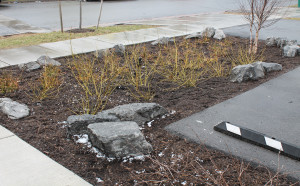Mar 13
2013
Buffalo a little greener in Lower West Side

In the summer it is not unusual to see children swimming in Black Rock Canal directly across from a pipe that can spew untreated sewer, storm runoff and toxic industrial chemicals into the water.
As gross and dangerous as that sounds, the following details may not be for those with weak stomachs. Consider yourself warned.
Each year about 52 million gallons of untreated storm runoff, industrial waste water and sewage enter Black Rock Canal. There are 14 permitted overflow pipes in this canal alone.
Buffalo Niagara Riverkeeper says some of the bacteria tests it conducted in the canal showed E. coli levels eight times above EPA standards.
The city’s combined storm water and sewer system is overburdened and it does overflow—untreated—into local waterways. On some days we all can smell a sewer stench when walking or bike riding the streets of Buffalo.
The Buffalo Sewer Authority has a state permit that allows it to discharge from 52 combined sewer overflow points at the Niagara River, Erie Basin, Buffalo River, Scajaquada Creek, Cazenovia Creek and Cornelius Creek and Black Rock Canal. Overflows are not uncommon for cities and counties that have old combined systems like in Buffalo and these localities are challenged with finding money for the fixes.
But it can get real bad here. In total, up to 4 billion gallons overflow into city waterways each year.
Enough of the gross stuff, right? What about efforts to control these overflows?
Wednesday morning at 460 Massachusetts Ave., PUSH Buffalo, along with a host of dignitaries, announced a green infrastructure program that will help reduce up to 2.8 million gallons of storm runoff from entering the city’s system each year in the Lower West Side.
PUSH Buffalo is a community organization that seeks more affordable housing in the Lower West Side, where more than 40 percent of the residents live in poverty. The partnership with PUSH Buffalo, Buffalo Niagara Riverkeeper, Buffalo Sewer Authority and the EPA involves $644,000 in state funding for 25 green projects in a 25-block area in the Lower West Side over the next two years. The money comes from an EPA grant and the state Environmental Facilities Corporation (EFC) picks the projects and funnels the money to the appropriate organizations. The Lower West Side project is one of 17 selected this year.
“Traditional storm water systems are already at or near capacity in many places and storm water runoff can overwhelm existing sewer systems, leading to pollution of waterways and even homes,” said Suzanna Randall, the EFC’s green infrastructure coordinator.
The Lower West Side will soon see more rain gardens that absorb runoff, roofs that have gardens to absorb rainfall and bioswails that remove runoff pollution and silt. Here is a map of the streets that will get, and already have, projects. Note in the map that the green boxes are planned projects and the blue boxes are existing projects.

A rain garden on Massachusetts Avenue that absorbs runoff so it doesn’t enter the city stormwater system.
There’s somewhat of a troubled history with the EPA and the Buffalo Sewer Authority that has brought the city to this point.
In 2001, the EPA reminded the Buffalo Sewer Authority to submit a long-term plan to control these overflows in compliance with the federal Clean Water Act.
Three years passed before the authority submitted a plan, but when it did the EPA said it was insufficient.
The EPA then ordered the Buffalo Sewer Authority a year ago to comply. The authority has since submitted that plan and has completed some green infrastructure projects in the city.
The EPA estimated it could cost between $300-$500 million over 15 years to install technology—some using green techniques—to control the overflows. The Buffalo Sewer Authority’s long-term plan includes more than $300 million in fixes and improvements.
“Sewage pollution in the Niagara River is degrading water quality and having a direct effect on the quality of people’s lives,” Judith Enck, EPA’s regional administrator for the area that includes Western New York, said last year after the EPA issued the order.
“Local fish are inedible and people can’t enjoy recreational water sports or local parks because of sewage odors. Buffalo has made improvements to its combined system in recent years, but much more must be done to protect people’s health and water quality.”
Enck is here this week to promote the Lower West Side project. She said Buffalo now has an opportunity to be a model for the nation.
“Green infrastructure is a real priority for the EPA,” she said. “When you walk in the streets you should never smell sewer.”
Jill Jedlicka, the executive director for Buffalo Niagara Riverkeeper, said the organization for a decade has been pushing for more green infrastructure that protects Buffalo waterways.
“We’re setting new standards of how we revitalize our communities,” Jedlicka said.

